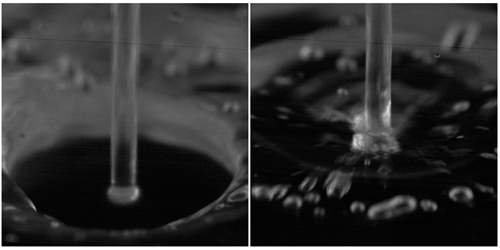Now You See It, Now You Don’t
Turn on a kitchen tap and an unexpectedly calm, shallow “pond” can appear where the water jet hits the sink. At first glance this pond appears still, but the water gushing outward from its outer bank shows otherwise. The bank, known as a circular hydraulic jump, is a boundary between two flow regimes and has been the subject of investigation for centuries—Leonardo da Vinci noted it in his journals. Now Aurélien Goerlinger of the Institute of Electronics, Microelectronics and Nanotechnology in France and his colleagues turn up a new feature in this familiar phenomenon [1]. They find that, under certain conditions, the pond can appear and disappear multiple times per second. The result could improve the efficiency of water-jet-based methods of cooling and cleaning.
Although circular hydraulic jumps are common, the appearance–disappearance phenomenon seen by the team presents only for jets that have a diameter of less than 1 mm and that hit a circular surface—in this experiment, a plexiglass plate. Comparing experimental data to a theoretical model of the system, the team determined that the effect stems from waves generated by the jump itself. These waves propagate outward from the jump, hit the edge of the surface, and then reflect inward. If the waves constructively interfere as they travel inward and outward, they repeatedly flood the pond and hide the hydraulic jump.
For those hoping to replicate these results at home, Goerlinger says that the appearance–disappearance cycle only manifests for a narrow range of experimental parameters. That’s probably why the phenomenon was missed before, he says. That or it was “regarded as noise without any physical significance.”
–Katherine Wright
Katherine Wright is the Deputy Editor of Physics Magazine.
References
- A. Goerlinger et al., “Oscillations and cavity modes in the circular hydraulic jump,” Phys. Rev. Lett. 131, 194001 (2023).




